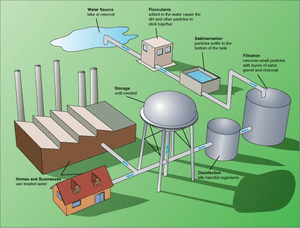Water treatment facts for kids
Water treatment is treating water to make it suitable for use. Water treatment removes contaminants and undesirable components, or reduces their concentration so that the water becomes fit for its desired end-use. This treatment is crucial to human health and allows humans to benefit from both drinking and irrigation use.
Many factories also need very clean water to make steam or to make high quality products. Some of this water has to be made very pure with almost no other chemicals dissolved in it.
Treating sewage so that it does not cause harm to the environment is another use of water treatment.
Contents
How is water treated to make it drinkable?
Drinking water is treated with reactive chemical agents such as suspended solids to remove bacteria, algae, viruses, fungi, and minerals including iron and manganese.
Water supplied to domestic properties such as for tap water or other uses, may be further treated before use, often using an in-line treatment process. Such treatments can include water softening or ion exchange.
How is wastewater treated?
The term "wastewater treatment" is often used to mean "sewage treatment". Processes commonly used in wastewater treatment include phase separation (such as sedimentation), biological and chemical processes (such as oxidation) or polishing. The main purpose of wastewater treatment is for the treated wastewater to be able to be disposed or reused safely.
How do people treat industrial water?
Different methods are used to degrade harmful substances in industrial water and make it suitable for discharge or use. One of them is physical treatment. It is when solids from industrial wastewater are separated from liquid. This is achieved either through Filtration or Dissolved air flotation. Filtration involves the use of Membrane or filters such as mechanical filters to achieve solid-liquid separation. Dissolved air flotation is when pressurized air is pumped into the wastewater. The pressurized air then forms small bubbles which adhere to the suspended matter causing them to float to the surface of the water where they can be removed by a skimming device or an overflow.
How is water disinfected?
In the past two decades Ultraviolet (UV) disinfection technology has been used to provide disinfected water without the use of harmful chemicals. The UV-C portion represents wavelengths from 200 nm - 280 nm which is used for disinfection. UV-C photons penetrate cells and damage the nucleic acid, rendering them incapable of reproduction, or microbiologically inactive.
Images for kids
See also
 In Spanish: Tratamiento de aguas para niños
In Spanish: Tratamiento de aguas para niños
- Control of water pollution
- Clean Water Act
- Peak water (water supply & demand)
- Pulsed-power water treatment
- Solar water disinfection
- Raw water#Treatment
- Water purification
- Water quality
- Water softening
- Water supply





